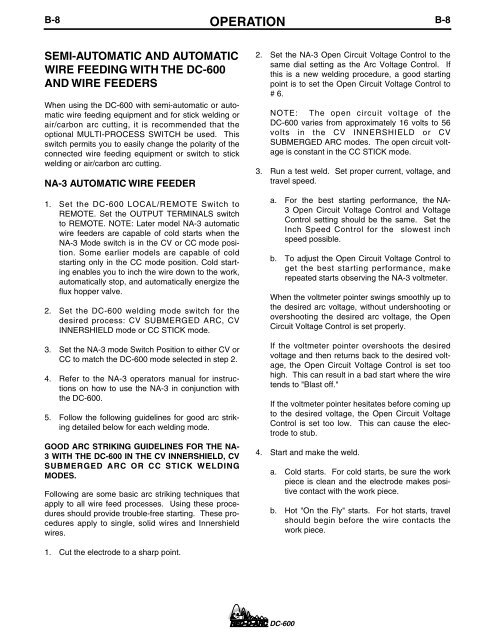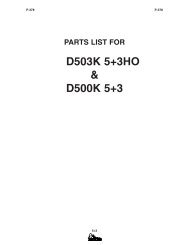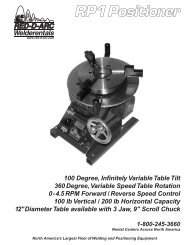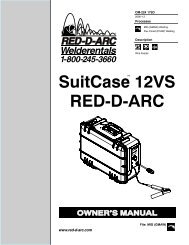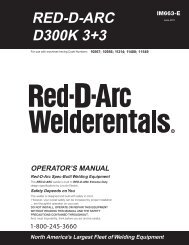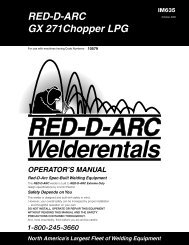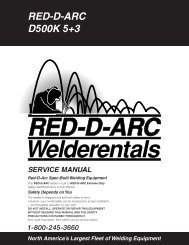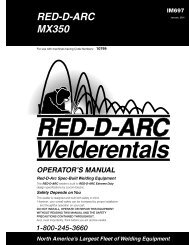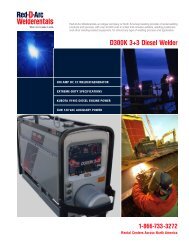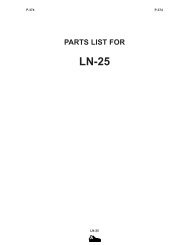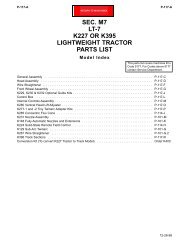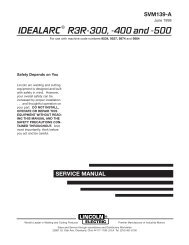RED-D-ARC DC-600
RED-D-ARC DC-600
RED-D-ARC DC-600
You also want an ePaper? Increase the reach of your titles
YUMPU automatically turns print PDFs into web optimized ePapers that Google loves.
B-8<br />
OPERATION<br />
B-8<br />
SEMI-AUTOMATIC AND AUTOMATIC<br />
WIRE FEEDING WITH THE <strong>DC</strong>-<strong>600</strong><br />
AND WIRE FEEDERS<br />
When using the <strong>DC</strong>-<strong>600</strong> with semi-automatic or automatic<br />
wire feeding equipment and for stick welding or<br />
air/carbon arc cutting, it is recommended that the<br />
optional MULTI-PROCESS SWITCH be used. This<br />
switch permits you to easily change the polarity of the<br />
connected wire feeding equipment or switch to stick<br />
welding or air/carbon arc cutting.<br />
NA-3 AUTOMATIC WIRE FEEDER<br />
1. Set the <strong>DC</strong>-<strong>600</strong> LOCAL/REMOTE Switch to<br />
REMOTE. Set the OUTPUT TERMINALS switch<br />
to REMOTE. NOTE: Later model NA-3 automatic<br />
wire feeders are capable of cold starts when the<br />
NA-3 Mode switch is in the CV or CC mode position.<br />
Some earlier models are capable of cold<br />
starting only in the CC mode position. Cold starting<br />
enables you to inch the wire down to the work,<br />
automatically stop, and automatically energize the<br />
flux hopper valve.<br />
2. Set the <strong>DC</strong>-<strong>600</strong> welding mode switch for the<br />
desired process: CV SUBMERGED <strong>ARC</strong>, CV<br />
INNERSHIELD mode or CC STICK mode.<br />
3. Set the NA-3 mode Switch Position to either CV or<br />
CC to match the <strong>DC</strong>-<strong>600</strong> mode selected in step 2.<br />
4. Refer to the NA-3 operators manual for instructions<br />
on how to use the NA-3 in conjunction with<br />
the <strong>DC</strong>-<strong>600</strong>.<br />
5. Follow the following guidelines for good arc striking<br />
detailed below for each welding mode.<br />
GOOD <strong>ARC</strong> STRIKING GUIDELINES FOR THE NA-<br />
3 WITH THE <strong>DC</strong>-<strong>600</strong> IN THE CV INNERSHIELD, CV<br />
SUBMERGED <strong>ARC</strong> OR CC STICK WELDING<br />
MODES.<br />
Following are some basic arc striking techniques that<br />
apply to all wire feed processes. Using these procedures<br />
should provide trouble-free starting. These procedures<br />
apply to single, solid wires and Innershield<br />
wires.<br />
2. Set the NA-3 Open Circuit Voltage Control to the<br />
same dial setting as the Arc Voltage Control. If<br />
this is a new welding procedure, a good starting<br />
point is to set the Open Circuit Voltage Control to<br />
# 6.<br />
NOTE: The open circuit voltage of the<br />
<strong>DC</strong>-<strong>600</strong> varies from approximately 16 volts to 56<br />
volts in the CV INNERSHIELD or CV<br />
SUBMERGED <strong>ARC</strong> modes. The open circuit voltage<br />
is constant in the CC STICK mode.<br />
3. Run a test weld. Set proper current, voltage, and<br />
travel speed.<br />
a. For the best starting performance, the NA-<br />
3 Open Circuit Voltage Control and Voltage<br />
Control setting should be the same. Set the<br />
Inch Speed Control for the slowest inch<br />
speed possible.<br />
b. To adjust the Open Circuit Voltage Control to<br />
get the best starting performance, make<br />
repeated starts observing the NA-3 voltmeter.<br />
When the voltmeter pointer swings smoothly up to<br />
the desired arc voltage, without undershooting or<br />
overshooting the desired arc voltage, the Open<br />
Circuit Voltage Control is set properly.<br />
If the voltmeter pointer overshoots the desired<br />
voltage and then returns back to the desired voltage,<br />
the Open Circuit Voltage Control is set too<br />
high. This can result in a bad start where the wire<br />
tends to "Blast off."<br />
If the voltmeter pointer hesitates before coming up<br />
to the desired voltage, the Open Circuit Voltage<br />
Control is set too low. This can cause the electrode<br />
to stub.<br />
4. Start and make the weld.<br />
a. Cold starts. For cold starts, be sure the work<br />
piece is clean and the electrode makes positive<br />
contact with the work piece.<br />
b. Hot "On the Fly" starts. For hot starts, travel<br />
should begin before the wire contacts the<br />
work piece.<br />
1. Cut the electrode to a sharp point.<br />
<strong>DC</strong>-<strong>600</strong>


